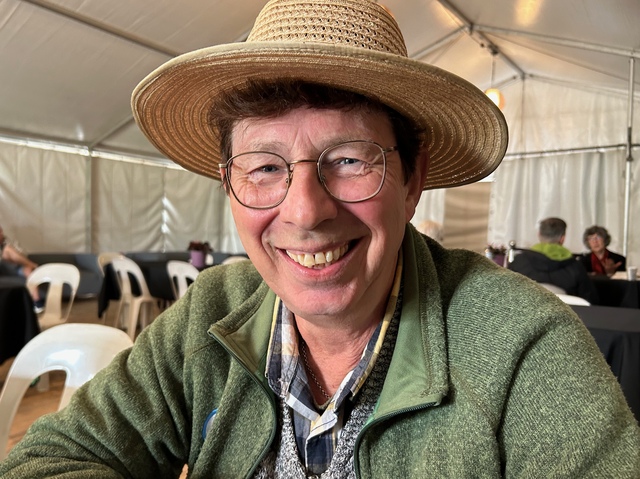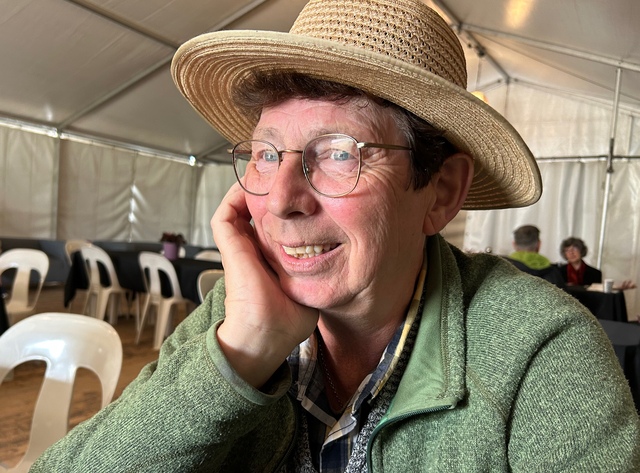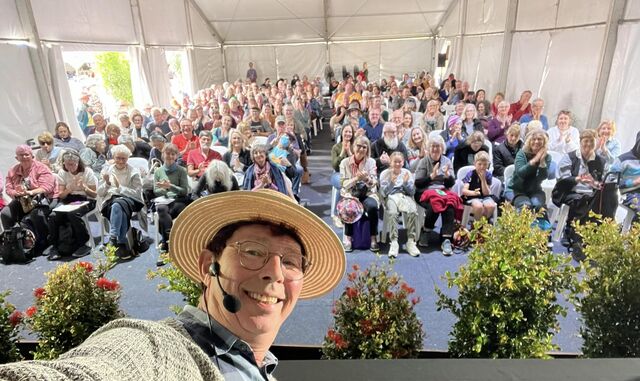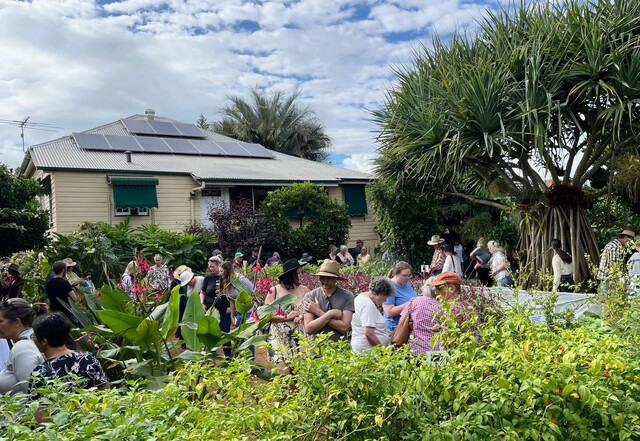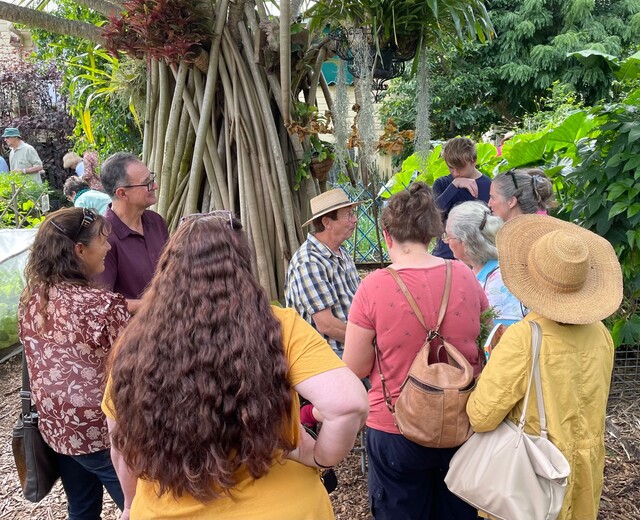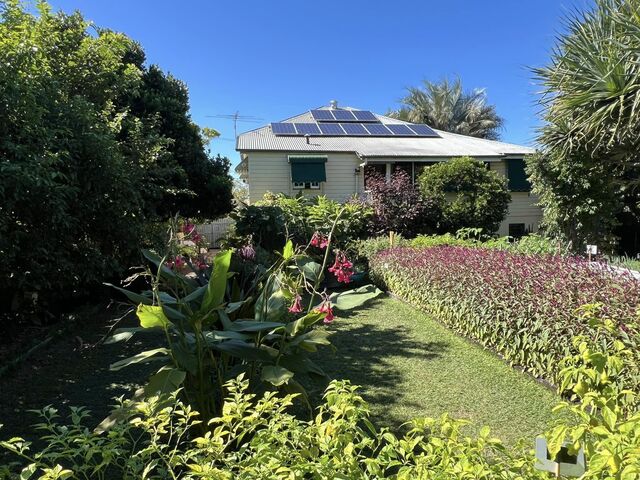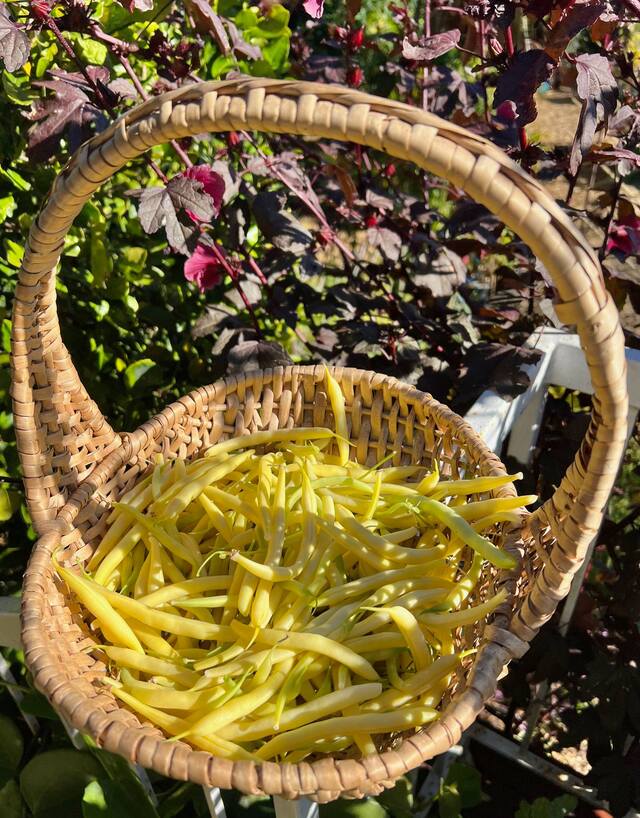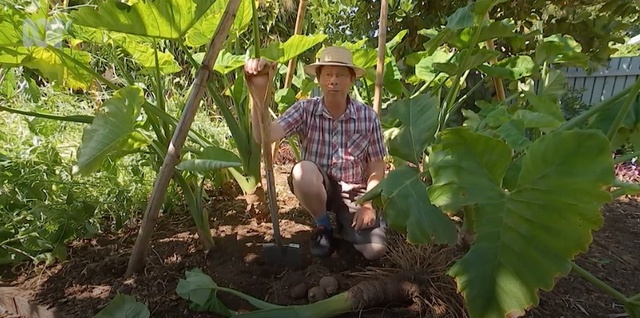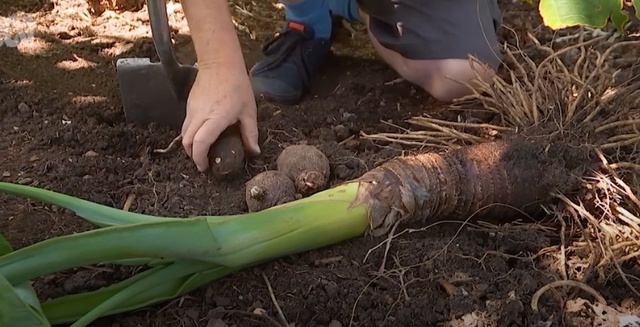You could say that gardening runs in the blood of Jerry Coleby-Williams.
His grandfather was a keen gardener and that proved vital to survive in England’s war years.
They were living in London and had come out of some really difficult times, including the Great Depression.
Having a home garden was a godsend.
Jerry‘s grandparents played a big role in his upbringing so little wonder that he learned about the value of gardening and its value to society.
I took the opportunity to talk to Jerry over a cup of tea and sandwiches at the recent Queensland Garden Expo.
In those moments you soon realise even though you have spoken with him over many years at times such as this, you realise how little you really know about the person.
Jerry is one of the familiar faces on ABC-TVs Gardening Australia and there, with his customary trademark boater-style straw hat, he told me about his life with plants.
We spoke about the value of gardens in the community and the changes he has seen since his childhood days in the UK.
Over the past 40 years the Queensland Garden Expo has been providing valuable information to thousands upon thousands of aficionados, gardening has evolved from traditional ornamental to a focus on sustainability, as we’ve seen a rise in native plants, water-wise gardening and urban food growing.
As our cities grow and regional landscapes evolve, creating sustainable and productive green spaces has never been more important, Jerry believes.
He draws upon his experiences from 20 years of sustainable gardening in Brisbane, which includes everything from starting a garden from scratch to dealing with droughts, floods, heatwaves and a few frosts in the coastal subtropics.
“I’ve been coming to the Expo for 20 years,” he said. “I came to Queensland for four months … I emigrated from Sydney to Brisbane in 2003, to reinvent myself.
“I had been running Sydney Botanic Gardens, the tree, grass and shrub department. I got the gardens pretty much as far as I could go with the government.
“We were on the brink of becoming the world’s first organic botanic garden – but it was too challenging. The minister said that if you go organic it puts pressure on all the other government departments to go likewise.
“So it was decided to adopt a continual improvement scheme as our policy. It was an easy way to proceed.
“I’d gone as far as I could with those gardens, then started with Gardening Australia – I’ve been with them 25 years. I was sort of a public figure – so thought it was important I should practice what I preach.
“I bought an unsuspecting 92-year-old Queenslander on Brisbane’s bayside – and created a model of affordable sustainable house and garden.
Jerry has been gardening since the age of four. Eventually he emerged from the Royal Botanic Gardens, Kew, qualified in horticultural estate management, arboriculture, landscape design, horticultural and botanical sciences.
In 1982 Kew awarded Jerry a scholarship to study the flora of Western Australia.
It changed his life. Captivated by the people, plants and places, he decided to emigrate.
The greatest impact was realising that bushland he visited had been pretty much unspoiled by industry – something that no European could ever experience in their native lands.
Post-graduate work included management of both public and private sector horticultural enterprises in Britain and Australia: nurseries, amenity tree maintenance, inner city parks and gardens, running a busy garden centre, and helping to establish Sydney’s Mt Annan Botanic Garden.
Jerry’s work as a consultant for Sydney renovation projects includes Darling Park, Central Station, St Mary’s Cathedral, the Conservatorium of Music, and the Sydney International Airport.
In Brisbane, his house generates solar power, recycles sewage and grey water, and harvests rainwater for house and garden use.
The ornamental, subtropical front garden grows plants suited to natural rainfall and predicted climate change. In the back garden Jerry grows fruit, vegetables, herbs and spices. There’s even a sustainable lawn, maintained by solar powered equipment. Everything is grown organically.
Jerry is a director of The Seed Savers Foundation, a community organisation which conserves rare and heritage plants, and is a member of the Australian Institute of Horticulture.
“So many projects have come out of my home,” he said. “The interest it’s generated has kept me employed for the past 20 years – in a way I never thought would be possible.
“People don’t believe that the food garden bed was just to demonstrate sustainability.
“The food garden was to prove that what my grandparents taught me in England could be applied here in Australia in the sub-tropics.
“What they taught me was that 100sq m of good soil could feed a family all year around.”
His grandparents taught him to do this in their backyard in London.
They had a quarter of an acre block a bit more than a mile from Greenwich, which is where the Royal Observatory is located – the home of time and space, the Prime Meridian and Greenwich Mean Time (GMT).
The Prime Meridian is used to indicate 0-degrees longitude, for measuring the world. This perhaps accounts for Jerry’s interest in being a record keeper.
“My mother was more of an ornamental gardener while my father worked in atomic weapons development – very different from everyone else I knew.
“He started with radar during the war, and he knew all the places they’d made movies about.”
Places such as Bletchley, where the code-breaking was explored through early computing methods.
“He was there on a regular basis. There were ‘away from work’ meetings he would go to.
“Gardening comes from a long family tradition, my great grandfather was a market gardener and green grocer in Colchester, Essex.
“He would say ‘you don’t put poison on your food’ – it was no deep philosophy, yet in so doing he saved money.
“It’s something I didn’t think much about before I became a qualified horticulturalist in the UK. Spraying was a part of everyday gardening.
“It has amazed me that the things we used have all been banned now. Some we knew were dangerous but others we were told they were perfectly safe to use.
“It was just one of those things that I slowly weaned myself off in a professional sense.”
When working in business or local council, you are not the master of your own future, Jerry said.
“You have to fit in with company or council policy then slowly you wean yourself away from those things.
“The Sydney Botanic Gardens was the best example of this. The way I started doing this was through turf – sustainable turf.
“The turf culture gets a bad rap – it was treated as an environmental disgrace, for all the wrong reasons.
“When I started work, there was 35ha, most of which was turf – the Domain, Botanic Gardens and Government House.
“All of the grass in those areas was regularly sprayed. We were spending 40 percent of the annual budget on replacing a hectare of turf every year due to wear and tear.
“Most people thought this was fine, because it was Australia’s most intensively visited space … a lot of feet means a lot of damage.
“So I spoke to the turf team – they weren’t happy with that, as they used the most pesticides and fungicides of any department.
“We developed a policy of reducing exposure to chemicals for staff. We started there.
“Despite the fact the gardens were Australia’s oldest scientific organisation, no-one had ever done a pH test of the lawns. They were very acidic with 5 to 5.2.
“Turf, even though it is treated like concrete or bitumen, prefers a pH of 6.5 – so we applied dolomite to the lawns as there was virtually no magnesium or calcium in those soils.
“We raised the height of the cut for the lawns, to get the turf as thick as we possibly could.
“Then it was a matter of working out what were the predominant turf types for the lawn. There were six different types, and each type needs a different cut according to the seasons.
“So we came out with a chart of what we had and started feeding the grass with granular poultry manure – an application in each season -and the result was so brilliant.
“We obliterated all of the weeds we had been spraying for by hiring a corer or de-thatcher. Within three years I’d pretty much saved 40 percent of the annual budget – and we were only replacing a few hundred square metres of turf instead of a hectare every single year.
“You could honestly say to people they could lie on the lawns because they were now chemical free.”
From this, the turf team – widely regarded as the cleaners of the botanical gardens – had an elevated status. They had gone from the most chemical dependent to the least chemical dependent and the results were visible – that propelled the culture for all the other areas of the gardens.
“The turf team was nervous – their reputation was on the line. They didn’t want to be the laughing stock or be criticised by management.”
Jerry’s move from New South Wales to Queensland was easy as he has gardened in Paris, Scotland and London.
“These were three pretty miserable climates, then I went to Western Australia.
“This is my fourth major climate zone in the world. It’s stimulating, you are learning things and constantly honing your advice to other people. I find that fun.”
In 2017 Jerry found the book Gardening In Queensland and in it Harry Oakman at Brisbane City Council said that in Queensland corn can be sown between the Ekka and the end of January.
“That’s a reasonable window,” Jerry said, “but the climate has warmed. I noticed in London the urban heat island effect allowed me to plant an Australian front garden in south east London – wattles, acacia, bottle brush.
“In 1985, that was the last month that anywhere in the world had a normal month of weather.
“In 2017 I thought of this and wondered if I could grow a crop of corn every month.
“So I undertook a ‘popcorn challenge’ of wanting a crop of corn to be ready for Mother’s Day – in the second week of May.”
Corn is generally regarded as a summer-ripening crop but Jerry succeeded – he had a viable crop of corn for Mother’s Day, and every month of the year.
“This year the zucchini have been flowering and fruiting all the way through winter.
“We need to remember in light of old gardening books that horticulture has changed and you have got to experiment.
“We always have to be pushing the envelope. That’s one of the great things about being here in the sub-tropics – you can always grow tropical plants in summer and English plants in winter.
“When you can sow crops is becoming more flexible.
“The downside is that at Christmas the corn crop was smashed down by those storms. I lost my polenta and bananas. I’ve only got the bananas flowering and fruiting again now.
“The secret is diversity and experimentation.
“People say I grow a large range of plants – which is true – I do like a big range of plants on my menu. Yet on the practical side, you might get a good year for turnips but a bad year for broad beans – you’ll always find there are winners and losers.
“Here in Queensland we garden in a continually surprising climate. So as long as you have that front of your mind when you are sowing, that everything in Queensland is experimental, then you are not upset if you lose something rather than assuming it as a dead cert.
“All life on earth is essentially experimental, so have fun experimenting – see how you can push the boundaries.”
Jerry’s advice to new gardeners is to start off simply.
“All gardeners start the same – no matter how far we might progress.
“I started at age four with lettuce, spring onions and radish. It was magic.
“To start with a plot of ground smaller than this table and within 12 weeks I had invited my grandparents around for afternoon tea on a Sunday, with food grown myself. It was just amazing.
“That’s what got me going. Creating food out of nothing. That’s what hooked me in. Then you experiment.”
So what are Jerry’s favourites to grow now?
“I got a Christmas cracker and it had a recipe for making a Chinese omelette, rather than a corny joke – egg fu-yong.
“That needed sprouts of mung bean – my grandparents had bought me some. In England in winter we had an airing cupboard, so I put the mung bean seed in some potting mix into a plastic bag then into the airing cupboard.
“I soon realised you don’t sprout seed into compost – but I made a meal. I made egg fu-yong at the age of nine, and it was the first time I’d ever sprouted seed.
“It was so fast and then to know you have a way of growing food in a small space.”
These days Jerry prefers to dig every crop in, and dig compost in every single time.
Former Gardening Australia Peter Cundall was a close friend of Jerry’s and he understood the lifestyle of his grandparents – the issues they faced, particularly food production, poverty, all those sorts of things that came out of the war.
“The nearest thing people have today of what shaped people such as Peter and my grandparents would be the supply chain issues we have had since Covid, the absence of convenience food in supermarkets because of that, and now we have the cost of living impacting mortgages and the ability to spend.
“It’s a comparative thing. During the ’70s in the UK there was a cost-of-living crises, due to the shortage of oil from the Middle East conflicts.
“Inflation at one stage was 25 percent. There were not individual prices on products but a whiteboard for bread, milk, sugar, and butter as prices were going up every single week.
“That’s when you have problems paying your mortgage. It was the winter of discontent.”
One of Jerry’s big discoveries has been the cocoyam from Brazil.
“The United Nations declared it as an under-exploited economic crop in the 70s – I was familiar with it in London, as I lived in a diverse place with a lot of Afro-Carribean food.
“There was a student at Kew Gardens – an enormous jolly giant of a guy – and he would have a huge bowl of mashed cocoyam with his lunch every day.
“I had been growing it since ’92 in Sydney. It’s a large perennial evergreen garden plant that produces leaves about two metres tall.
“The young leaves are cooked like spinach, while new cornlets are the equivalent of new potatoes (tubulars at the base).
“The stem can be as thick as my thigh – you can peel, dice, and make mashed potato or soup from it.
“Use the stems by steeping, peeling and squeezing out the sap, then washing under a running tap.
“You can get four crops – and potentially flour – all from one plant. It can be made it into low-GI gluten-free starch.
“This is a drought-resistant, flood-resistant crop that can be grown year round.
“If you like taro you can grow this in dry land with a quarter of the water. It’s no longer produced commercially in Queensland – the only hope is community gardens.”
Every Mother’s Day weekend Jerry has an open day at his house in Wynnum.
“You have to embrace life,” he said. “Take opportunities and take a punt – when they come up.
“Like moving from WA to the Sydney Botanic Gardens, that was a punt.
“You look back at life and the opportunities that come up. It’s a matter of knowing to take them. Things happen at a time, for a reason.
“There can be all sorts of goals and dreams. A bit like plants. But some times you just have to give things a bit of a push.
“I had no problems at all coming to Australia – it was just magic.
“The Western Australian climate was just perfect. A wet winter and gorgeously warm summer.”
In Jerry’s time in Queensland he has seen front gardens transformed from gerberas and palm trees to very diverse plantings reflecting the sub-tropical environment.
His final piece of advice reflects that love of keeping records.
“You can’t manage what you can’t measure.
“When managing a project … check for efficiency and effectiveness.”

